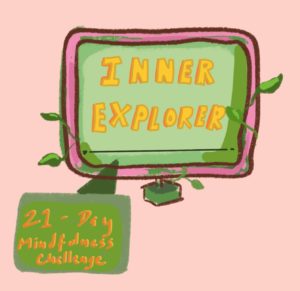21-Day Mindfulness Challenge
Does Inner Explorer Work?
 To describe the past year as stressful would be a complete understatement. Our stresses have skyrocketed due to the challenges posed by the COVID-19 pandemic and it especially resonates with students and teachers. To tackle this problem, the DMAE community decided to take on Inner Explorer’s 21-day Mindfulness Challenge which began in late March of 2021, as the third marking period began.
To describe the past year as stressful would be a complete understatement. Our stresses have skyrocketed due to the challenges posed by the COVID-19 pandemic and it especially resonates with students and teachers. To tackle this problem, the DMAE community decided to take on Inner Explorer’s 21-day Mindfulness Challenge which began in late March of 2021, as the third marking period began.
Mindfulness, like its name, is a method to be more mindful of yourself. Instead of shutting out your racing or negative thoughts, mindfulness allows you to acknowledge those thoughts so they do not interrupt your focus for the rest of the day. Principal Benjamin Suro explained the impact a few minutes of mindfulness can have on someone’s day.
“Starting your day acknowledging where you are, how you feel, your apprehension, your stress, the challenges for the day, what makes you happy ─ if you have a moment to put all those things into five or six minutes to start your day, I think you set yourself up for having a good day,” Mr. Suro said.
This challenge vastly transformed the morning routines of all DMAE community members. Yet, due to the virtual platform school has been operating under, meeting this Mindfulness Challenge was not a given: time, tech and other issues arose.
Teacher Melissa Conceicao, who is the club adviser of Project Happiness and a big proponent of the 21-day Mindfulness Challenge, explained why.
“When in the classroom, a teacher’s physical presence can help give students the push they need to participate. Students are also more likely to participate when they see others involved in the classroom. However, in a remote setting, when things are not done in person, teachers have a much more difficult time getting ‘buy-in,’” Ms. Conceicao said.
Some students were thrilled.
“Being able to finally sit down and reflect on my life is extremely stress relieving. I sometimes overwork myself and I get too caught up in stress. But with the help of mindfulness, life gets a lot happier,” sophomore Chris Restrepo said.
On the other hand, some students were apathetic or annoyed.
“I have other ways to relax and calm myself down, like watching a movie or taking a nap. Since this was done during school when I’m in the mindset to just do work, it was hard for me to focus on being mindful. Overall, I don’t really think it had a huge benefit for me, ” junior Julie Jang explained.
Teachers also had mixed feelings about the Mindfulness Challenge, as it was an abrupt change to their morning routine.
“I think the problem in our school is that we seem to always start in the middle of the year. It is very hard to get students to change their morning routines,” explained English teacher Mindy Rochman. “I think this could have been more impactful if we had started at the beginning of the year and all teachers participated. If a teacher isn’t going to buy into it, why should their students?” she said.
As if in answer to Ms. Rochman, Principal Suro hopes to continue integrating mindfulness for the years to come, beginning with the first day of school next year. Mr. Suro also explained how there is a stigma surrounding the idea of taking care of one’s mental health. It can be perceived as “being too weak or too sensitive” by others. But he explained that there is both quantitative and qualitative evidence that shows how mindfulness leads to “an overall sense of feeling happier” and increased academic performance.
“We need some time to focus on ourselves and be happy,” Mr. Suro said.
Ms. Conceicao wholeheartedly agreed.
“Mental health issues need to be normalized and so do the practices to help manage them,” she said.


